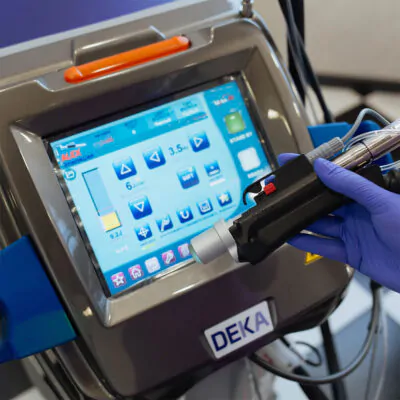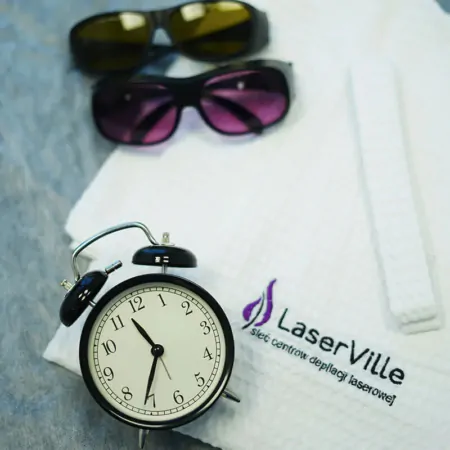Epilation or depilation, what is the difference?
These two concepts are often confused with each other. However, both procedures involve one thing – the removal of unwanted hair. Let’s sort out and clarify the difference between epilation and depilation and how to find the ideal way to remove hair.
Depilation
Depilation is hair removal methods that do not affect the hair follicles. As a result, hair growth is not disrupted, and procedures must be repeated at short intervals.
Types of depilation
- Shaving – the most popular method of hair removal, where the visible part of the hair is removed with a razor. The main drawback of this method is the short-term effect (1-3 days).
- Waxing – a depilation method where special cosmetic wax is applied, which adheres to the hair. The wax is then removed using special wipes. For effective depilation with this method, the hair length should be between 4 and 10 mm, which can be uncomfortable for women, especially in the summer.
 Sugaring – another depilation technique similar to waxing. The main difference from waxing is the use of a special sugar paste, which is removed in the direction of hair growth. In terms of duration and pain sensations, these two methods are very similar. However, the risk of ingrown hairs is lower with sugaring.
Sugaring – another depilation technique similar to waxing. The main difference from waxing is the use of a special sugar paste, which is removed in the direction of hair growth. In terms of duration and pain sensations, these two methods are very similar. However, the risk of ingrown hairs is lower with sugaring.- Mechanical Depilator – the removal of the entire hair with the root using a depilation machine. The machines have rotating plates or vibrating springs that remove hair like tweezers. The process is quite painful and lengthy. The device does not capture the smallest hairs.
- Chemical Depilation – a hair removal method using a cream, gel, or lotion. The product is applied to the skin, where it reacts with the hair and destroys it. However, the substance cannot penetrate the skin deeply enough without causing severe burns. Therefore, it can only affect the hair root in places where it reaches the follicle; otherwise, it only removes the visible part of the hair.
Epilation
Epilation is the removal of hair accompanied by damage to the hair follicles, resulting in no regrowth.
There are several myths regarding this term. The first: epilation is hair removal forever. Unfortunately, no method currently exists that allows for the permanent removal of unwanted hair. A good result is considered to be a 90% reduction in hair quantity, and the bold promises of beauty salons are nothing more than marketing tactics.
The second myth: epilation is harmful to the body. Health risks are possible if basic procedure rules are not followed or if a person has contraindications. Main contraindications include pregnancy, the presence of malignant tumors, diabetes, and dermatological diseases in an active phase.
 Types of Epilation
Types of Epilation
- Photoepilation – this method is based on the impact of high-intensity light, resulting in hair destruction. The essence lies in the absorption of light waves by melanin. The effectiveness of the procedure depends on the amount of melanin. The lighter the hair, the less effective the procedure. The advantage of this method is skin rejuvenation – the principles of photoepilation and photorejuvenation are similar.
- Electroepilation – this involves the destruction of the hair follicle using an electric current. This type of epilation is performed with tweezers or a needle. In the tweezers method, high-frequency current is applied to each hair. The duration of exposure is 1.5-2 minutes, making it unsuitable for large body areas. Electroepilation with a sterile needle involves inserting the needle under the skin. The advantage is the destruction of even gray, pigmentless hair. However, this method is not suitable for people with a low pain threshold as the procedure is very painful. Additionally, skin recovery can be lengthy (up to 2 months). Complications such as burns, hematomas, and scars are possible, especially for susceptible skin.
- Laser Epilation – one of the most effective hair removal methods today. Laser epilation is based on the destruction of hair follicles using laser radiation. The laser beam, like photo systems, affects melanin. However, there are differences between these methods. The laser emits a single wavelength, whereas krypton lamps used in photoepilators emit multiple wavelengths. Consequently, the effectiveness is reduced, especially on lighter hair, and the health risk is higher compared to the laser.
In conclusion, if you have no obvious contraindications for epilation, be sure to use this method. It will keep your skin smooth for a long time. You will be free from skin irritation and ingrown hairs.
When choosing a clinic, pay attention to the equipment used in the salon. Check if the staff has medical education and the client reviews of the beauty salon.
In the Laser Ville salon network, laser epilation masters use equipment from the Italian manufacturer Deka. This is the Alexandrite laser Motus AX with Moveo technology. This technology allows for quick and painless procedures. It removes even the lightest hairs and has no contraindications for tanned or naturally dark skin.































No reviews